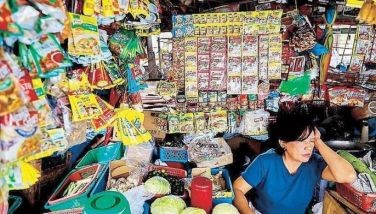Poverty, income inequality remain high in Phl
MANILA, Philippines - Despite robust economic growth so far this year and a series of international credit rating upgrades, inclusive growth and poverty alleviation still elude the Philippines.
The country’s gross domestic product (GDP) grew an impressive 7.8 percent in the first three months of 2013, after an equally strong growth rate of 6.8 percent in whole of 2012.
But Socioeconomic Planning Secretary Arsenio M. Balisacan said compared to other Asian countries, the Philippines still has the lowest total investment share to GDP from 2010-2012 relative to India, Indonesia, Malaysia, Thailand and Vietnam.
“Poverty incidence remains high, and so does income inequality. Moreover, more than 60 percent of the entire country’s economic growth is concentrated in Metro Manila, Calabarzon, and Central Luzon,†Balisacan said at a recent forum by the Philippine Council for Industry, Energy, and Emerging Technology Research and Development (PCIEERD).
Substantial poverty reduction achieved in developing countries in the past two decades was due to rapid economic growth and structural transformation in these countries, particularly in Asia. Globally, this growth contributed nearly two-thirds of the observed poverty reduction in the developing world.
“A one-percent increase in GDP per capita reduces poverty by 1.7 percent,†Balisacan said.
Likewise, the country’s economic growth barely exceeded the population growth rate, which has continued to expand relatively rapidly at about two percent a year.
Thus shifting the economy to a higher growth path – and keeping it there for the long term – should be first and foremost on the development agenda.
Balisacan, who is also the director general of the National Economic and Development Authority (NEDA), said that inequality in incomes and opportunities could weaken the power of economic growth as a key strategic vehicle for eliminating acute poverty.
Rising inequality could also undermine political and social stability, which is a necessary condition for sustainable development and prosperity.
He further stressed that inclusive growth does not come by chance, adding that it requires deliberate policies that expand opportunities for remunerative employment and human development.
Balisacan went on inclusive growth demands development in the periphery through integration of the lagging areas or regions with the fast-growing, leading areas or regions of the country. Large-scale targeted programs also need to be in place to directly assist those who are unable to participate in the growth process.
Balisacan assured though that government is now creating new drivers of growth that would generate high quality jobs and strengthen regional competitive advantages.
The Philippine Development Plan 2011-2016 (and its revised edition) as well as various regional development plans have identified priority industries that, according to Balisacan, “present the highest growth potentials and generate the most jobs.â€
The revised PDP would put more emphasis on employment generating sectors such as manufacturing, agriculture, tourism, information technology-business process outsourcing, agri-business, and housing.
Putting greater pressure on infrastructure development is one of the crucial steps, which includes improving the processes related to the public-private partnership (PPP). “The pace of implementation has been slower than desired,†Balisacan further admitted.
But the strategic goal for inclusive and sustainable growth, he said, lies in the use of technology, improvements in policy, and institutional reforms.
Countries must invest in research and development (R&D) and good governance, he added.
“We need to channel our efforts towards increasing the productivity of agriculture and industries through science and technology, and improve the links between agriculture and industry so that high quality jobs can be created, especially for the unskilled,†the NEDA chief said.
S&T innovations that directly improve the quality of life, especially those related to health, safety, and environmental quality, are also crucially needed. Other sectors in the economy also have critical issues that could be addressed by advances in S&T.
- Latest
- Trending































